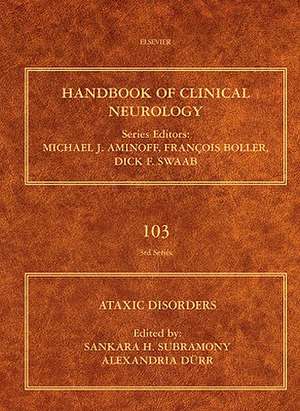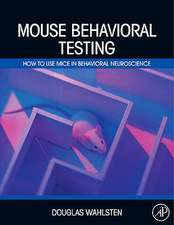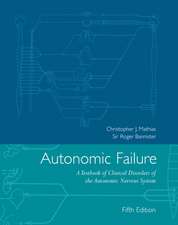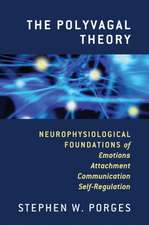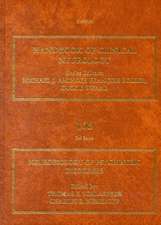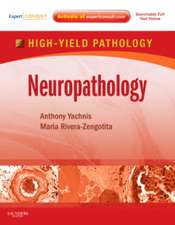Ataxic Disorders: Handbook of Clinical Neurology, cartea 103
Editat de Sankara H. Subramony, Alexandra Dürren Limba Engleză Hardback – 21 sep 2011
Clinicians will gain a broader understanding of generative ataxias and the genetic disorders associated with them. In addition, new neurophysiological and imaging techniques are discussed, along with an in-depth examination of the treatment and management protocols of ataxic diseases.
- A volume in the Handbook of Clinical Neurology series, which has an unparalleled reputation as the world's most comprehensive source of information in neurology
- International list of contributors including the leading workers in the field
- Describes the advances which have occurred in clinical neurology and the neurosciences, their impact on the understanding of neurological disorders and on patient care
Din seria Handbook of Clinical Neurology
- 20%
 Preț: 1274.52 lei
Preț: 1274.52 lei - 20%
 Preț: 1311.43 lei
Preț: 1311.43 lei - 23%
 Preț: 1286.74 lei
Preț: 1286.74 lei - 20%
 Preț: 1344.20 lei
Preț: 1344.20 lei - 20%
 Preț: 1349.51 lei
Preț: 1349.51 lei - 24%
 Preț: 1275.78 lei
Preț: 1275.78 lei - 20%
 Preț: 1344.02 lei
Preț: 1344.02 lei - 20%
 Preț: 1339.70 lei
Preț: 1339.70 lei - 20%
 Preț: 1316.98 lei
Preț: 1316.98 lei - 20%
 Preț: 1315.38 lei
Preț: 1315.38 lei - 20%
 Preț: 1329.13 lei
Preț: 1329.13 lei - 20%
 Preț: 1313.06 lei
Preț: 1313.06 lei - 5%
 Preț: 1309.43 lei
Preț: 1309.43 lei - 5%
 Preț: 1300.74 lei
Preț: 1300.74 lei - 20%
 Preț: 1302.98 lei
Preț: 1302.98 lei - 20%
 Preț: 1304.03 lei
Preț: 1304.03 lei - 20%
 Preț: 1304.66 lei
Preț: 1304.66 lei - 20%
 Preț: 1303.13 lei
Preț: 1303.13 lei - 20%
 Preț: 1319.00 lei
Preț: 1319.00 lei - 20%
 Preț: 1312.90 lei
Preț: 1312.90 lei - 5%
 Preț: 1304.05 lei
Preț: 1304.05 lei - 5%
 Preț: 1305.77 lei
Preț: 1305.77 lei - 20%
 Preț: 1303.05 lei
Preț: 1303.05 lei - 20%
 Preț: 1312.24 lei
Preț: 1312.24 lei - 20%
 Preț: 1304.66 lei
Preț: 1304.66 lei - 20%
 Preț: 1300.34 lei
Preț: 1300.34 lei - 20%
 Preț: 1148.33 lei
Preț: 1148.33 lei - 5%
 Preț: 1221.37 lei
Preț: 1221.37 lei - 25%
 Preț: 1256.05 lei
Preț: 1256.05 lei - 21%
 Preț: 1062.72 lei
Preț: 1062.72 lei - 23%
 Preț: 1126.07 lei
Preț: 1126.07 lei - 19%
 Preț: 1070.63 lei
Preț: 1070.63 lei - 20%
 Preț: 1069.47 lei
Preț: 1069.47 lei - 25%
 Preț: 1178.93 lei
Preț: 1178.93 lei - 5%
 Preț: 1187.28 lei
Preț: 1187.28 lei - 25%
 Preț: 1165.32 lei
Preț: 1165.32 lei - 19%
 Preț: 1180.73 lei
Preț: 1180.73 lei - 25%
 Preț: 1165.86 lei
Preț: 1165.86 lei - 19%
 Preț: 1178.74 lei
Preț: 1178.74 lei - 25%
 Preț: 1175.31 lei
Preț: 1175.31 lei - 5%
 Preț: 1343.67 lei
Preț: 1343.67 lei - 5%
 Preț: 1338.90 lei
Preț: 1338.90 lei - 5%
 Preț: 1175.59 lei
Preț: 1175.59 lei - 5%
 Preț: 1165.40 lei
Preț: 1165.40 lei - 20%
 Preț: 1225.89 lei
Preț: 1225.89 lei - 24%
 Preț: 1165.66 lei
Preț: 1165.66 lei - 25%
 Preț: 1226.82 lei
Preț: 1226.82 lei
Preț: 1203.24 lei
Preț vechi: 1266.56 lei
-5% Nou
Puncte Express: 1805
Preț estimativ în valută:
230.31€ • 250.26$ • 193.59£
230.31€ • 250.26$ • 193.59£
Carte tipărită la comandă
Livrare economică 14-28 aprilie
Preluare comenzi: 021 569.72.76
Specificații
ISBN-13: 9780444518927
ISBN-10: 0444518924
Pagini: 680
Ilustrații: Approx. 186 illustrations (49 in full color)
Dimensiuni: 192 x 262 x 269 mm
Ediția:3
Editura: ELSEVIER SCIENCE
Seria Handbook of Clinical Neurology
ISBN-10: 0444518924
Pagini: 680
Ilustrații: Approx. 186 illustrations (49 in full color)
Dimensiuni: 192 x 262 x 269 mm
Ediția:3
Editura: ELSEVIER SCIENCE
Seria Handbook of Clinical Neurology
Public țintă
NeurologistsNeuroscience research workers
Cuprins
BASIC ASPECTS
The cerebellum - structure and connections; Physiology of clinical dysfunction of the cerebellum; Oculomotor aspects of the hereditary cerebellar ataxias; Magnetic resonance and nuclear medicine imaging studies in ataxic disease; Neuropathology of degenerative ataxias; Approach to ataxic diseases
ACQUIRED ATAXIAS
Acquired ataxias, infectious and para-infectious; Ataxia in patients with brain infarcts and hemorrhages; Ataxia resulting from posterior fossa tumors of childhood and other mass lesions; Nutritional cerebellar degeneration, with comments on its relationship to Wernicke disease and alcoholism; Immune-mediated acquired ataxias; Toxic agents causing cerebellar ataxias; Paraneoplastic cerebellar degeneration
DEGENERATIVE ATAXIAS
Epidemiology and population genetics of degenerative ataxias; Sporadic adult onset ataxia of unknown aetiology
DEGENERATIVE ATAXIAS – MITOCHONDRIAL, AUTOSOMAL RECESSIVE AND X-LINKED
Overview of autosomal recessive ataxias; Friedrich’s ataxia; Ataxia with vitamin E deficiency and abetalipoproteinemia; Ataxia-telangiectasia; Autosomal recessive cerebellar ataxias with oculomotor apraxia; Other autosomal recessive and childhood ataxias; Ataxia in mitochondrial disorders; Fragile X-associated tremor/ataxia syndrome
DEGENERATIVE ATAXIAS – AUTOSOMAL DOMINANT
Overview of autosomal dominant ataxias; Spinocerebellar ataxia type 1, 2; Machado-Joseph disease/spinocerebellar ataxia type 3; Spinocerebellar ataxia type 5, 6, 7; Clinical and genetic features of spinocerebellar ataxia type 8; Spinocerebellar ataxia type 10, 11, 12, 13, 14, 15, 20, 25, 28; Other spinocerebellar ataxias; Dentatorubral-pallidoluysian atrophy; Episodic ataxias 1 and 2
OTHER ISSUES
Ataxias related to sensory neuropathies; Frontal lobe ataxia; Balance and gait problems in the elderly; Treatment and management issues in ataxic disease
The cerebellum - structure and connections; Physiology of clinical dysfunction of the cerebellum; Oculomotor aspects of the hereditary cerebellar ataxias; Magnetic resonance and nuclear medicine imaging studies in ataxic disease; Neuropathology of degenerative ataxias; Approach to ataxic diseases
ACQUIRED ATAXIAS
Acquired ataxias, infectious and para-infectious; Ataxia in patients with brain infarcts and hemorrhages; Ataxia resulting from posterior fossa tumors of childhood and other mass lesions; Nutritional cerebellar degeneration, with comments on its relationship to Wernicke disease and alcoholism; Immune-mediated acquired ataxias; Toxic agents causing cerebellar ataxias; Paraneoplastic cerebellar degeneration
DEGENERATIVE ATAXIAS
Epidemiology and population genetics of degenerative ataxias; Sporadic adult onset ataxia of unknown aetiology
DEGENERATIVE ATAXIAS – MITOCHONDRIAL, AUTOSOMAL RECESSIVE AND X-LINKED
Overview of autosomal recessive ataxias; Friedrich’s ataxia; Ataxia with vitamin E deficiency and abetalipoproteinemia; Ataxia-telangiectasia; Autosomal recessive cerebellar ataxias with oculomotor apraxia; Other autosomal recessive and childhood ataxias; Ataxia in mitochondrial disorders; Fragile X-associated tremor/ataxia syndrome
DEGENERATIVE ATAXIAS – AUTOSOMAL DOMINANT
Overview of autosomal dominant ataxias; Spinocerebellar ataxia type 1, 2; Machado-Joseph disease/spinocerebellar ataxia type 3; Spinocerebellar ataxia type 5, 6, 7; Clinical and genetic features of spinocerebellar ataxia type 8; Spinocerebellar ataxia type 10, 11, 12, 13, 14, 15, 20, 25, 28; Other spinocerebellar ataxias; Dentatorubral-pallidoluysian atrophy; Episodic ataxias 1 and 2
OTHER ISSUES
Ataxias related to sensory neuropathies; Frontal lobe ataxia; Balance and gait problems in the elderly; Treatment and management issues in ataxic disease
